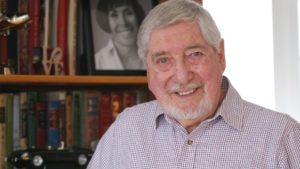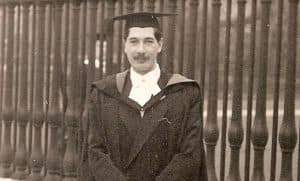“Nothing I have done since can match that,” Alex Kanarek wrote on Facebook

Sixty years after he helped mass produce the polio vaccine in England, a Rockwood, Ont. man is celebrating news from the World Health Organization that the disease could soon be a thing of the past.
In February, Alex Kanarek came across a WHO statement that said reported cases of polio were at “an all-time low in 2017,” and that we are “closer to polio eradication than ever before.”
That news prompted him to write the following message on his Facebook page:
“In 1958, exactly 60 years ago, the British government started vaccinations against polio with vaccine manufactured by two British companies, Glaxo and Burroughs, Wellcome. I was a member of the Wellcome team that developed and produced the vaccine… Nothing I have done since can match that in terms of my direct effect on children’s health.”
Mass production
Kanarek’s story began in 1954, when he was hired by Burroughs Wellcome to find a way to produce enough polio vaccine to vaccinate all the children in the United Kingdom.
American medical researcher Jonas Salk had just announced that his vaccine against polio worked, but no one knew how to make the vaccine on a large scale.
“It soon became obvious that the methods that we were using were not going to be adequate,” Kanarek told CBC News. “Until then, people had been working with test tubes and little bottles, you see what I mean? We were now talking about 100 litres tanks.”
What needed to happen, Kanarek said, is that the process of manufacturing vaccines needed to be industrialized, and it fell to him and his small team of scientists and technicians to sort out what that would look like.
“We were learning on the job,” he said. “Every day we had another problem to solve, and that was the exciting part.”

In the end, Kanarek helped to design a three-storey building on the Burroughs Wellcome campus in Beckenham, just south of London, where the polio vaccine was produced.
When the building opened in 1958, a local newspaper ran the following photo of Kanarek and one of his technicians standing beside one of the stainless-steal mixing tanks he designed.
When the reporters left the building, Kanarek said the real work began. They closed the doors, fired up the system and started producing the vaccine.
He said they produced 3 million doses of polio vaccine over the next three or four years — 3 million doses that protected children from a deadly disease.
“That was a wonderful achievement, not just for me, of course, but for the whole team that did that job,” he said.

But then, in 1961, another American researcher — Albert Sabin — created a new vaccine, one that was much easier to produce and administer.
Burroughs Wellcome phased out its production of the Salk vaccine and started producing the new Sabin one instead.
Kanarek was still working for the company, but had moved on to other viruses and vaccines. So, when he thinks about polio, it’s the early days that he remembers.
“What I remember most is that we were young, we were so enthusiastic,” he said. “We were right at the beginning of this enormous achievement, which now — 60 years later — it’s just something everybody expects.
“We have vaccines against all these different virus diseases and they work and they’re safe, but back then we were right at the beginning of it and that was very exciting.”


